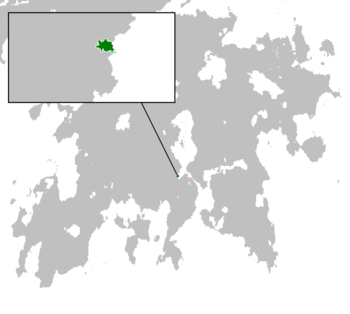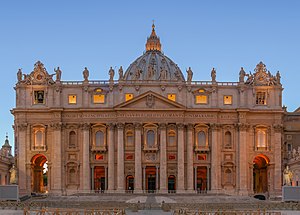Silvadum City: Difference between revisions
mNo edit summary |
|||
| (2 intermediate revisions by the same user not shown) | |||
| Line 1: | Line 1: | ||
{{Region icon Anteria}}{{WIP}} | {{Region icon Anteria}}{{NSNIcon|Silvadum_City|Silvadum City}}{{WIP}} | ||
{{Infobox country | {{Infobox country | ||
|micronation = <!--yes if a micronation--> | |micronation = <!--yes if a micronation--> | ||
| Line 50: | Line 50: | ||
|leader_name1 = [[wikipedia:Holy See|Holy See]] | |leader_name1 = [[wikipedia:Holy See|Holy See]] | ||
|leader_title2 = [[wikipedia:Pope|Sovereign]]<!--(could be "Vice President", otherwise "Prime Minster", etc, etc)--> | |leader_title2 = [[wikipedia:Pope|Sovereign]]<!--(could be "Vice President", otherwise "Prime Minster", etc, etc)--> | ||
|leader_name2 = | |leader_name2 = {{Incumbent pope Anteria}}{{efn|Silvadum does have a king, which is by definition the same person as the pope, although technically the titles remain seperate}} | ||
|leader_title3 = Secretary of State | |leader_title3 = Secretary of State | ||
|leader_name3 = | |leader_name3 = | ||
Latest revision as of 09:17, 16 August 2021
This article is incomplete because it is pending further input from participants, or it is a work-in-progress by one author. Please comment on this article's talk page to share your input, comments and questions. Note: To contribute to this article, you may need to seek help from the author(s) of this page. |
Silvadum City State | |
|---|---|
 Location of Silvadum City (green) in Thrismari (dark grey) | |
| Capital and largest city | Silvadum City (City-state) |
| Official languages | Latin[a] Medovian |
| Religion | Catholicism (Official religion) |
| Demonym(s) | Silvadian |
| Government | Unitary Christian absolute monarchy |
| Holy See | |
| Luke VII[b] | |
| Legislature | Pontifical Commission |
| Population | |
• 2018 estimate | 912 |
• 2014 census | 906 |
| Currency | Deru[c] |
| Time zone | UTC-2 |
| Date format | yyyy-mm-dd (AD) |
| Driving side | right |
| Calling code | +777 |
| ISO 3166 code | SD |
| Part of a series on the |
| Catholic Church |
|---|
 |
| Overview |
Silvadum City (Classical: /ˈs̠ɪɫ̪u̯äd̪ʊ̃ˑ/; Ecclesiastical: /ˈsilvɑːd̪um/), officially the Silvadum City State (Medovian: Erbes Śtot de Silvadi; Latin: Status Civitatis Silvadi; Diacritic Latin: Status Cīvitātis Silvādī) is a city-state governed by the Holy See in Gavarnik, the capital of Medovia. It is a official residence of the pope and de facto central point to the Catholic Church.
History
Before Christianity
The name Silvadum comes from old Latin settlement, named "Silva Vadum" ("𐌔𐌉𐌋𐌖𐌀 𐌖𐌀𐌃𐌖𐌌" as written in at the time used Old Latin script), meaning "The Wooden Ford" in Common. Over centuries, the va in the first word merged with the second word, creating the term "Silvadum". The first record with the new name comes from the 4th century BC, noting, that in Silvadum, there was a flood.
The area of Silvadum became later part of the Gavarnik city, which administered it and operated a fort in the location.
Arrival of Christianity
Traditionally, Saint Peter arrived in Gavarnik at around 57 AD, being crucified in 68 AD (some sources provide 62 or 64 AD). At that time, the Christian church in Gavarnik is already expected to be established, despite the prosecution from the imperial power.
The next 35 popes (at that time only regular bishops just like any other bishop) of Gavarnik were porsecuted as well, being mostly martyred or living in hiding, settling the Christian doctrine and spreading Christianity across the area. In 380 AD (some sources provide 382 or 383 AD), the local administration adopted Christianity as the official religion, putting the definite end to the centralized persecution of Christians.
Christian dominance
TBA
Late history
TBA
Papacy

Popes in Silvadum
As of 2021, there were 16 popes which operated from the Silvadum City State:
| № | Common name | Latin name | From | Until | Ended by | |
|---|---|---|---|---|---|---|
| 1 | Pius VIII | Pivs VIII | 1848 | 1856 | NATURAL DEATH | |
| — | 1856 | 1858 | CONCLAVE | |||
| 2 | John XII | Ioannvs XII | 1858 | 1861 | UNFITNESS | |
| 3 | Philip III | Philippvs III | 1861 | 1869 | NATURAL DEATH | |
| 4 | Pius IX | Pivs IX | 1869 | 1878 | NATURAL DEATH | |
| 5 | Michael II | Michælis II | 1878 | 1900 | NATURAL DEATH | |
| 6 | Benedict VIII | Benedictvs VIII | 1900 | 1911 | ACCIDENT | |
| 7 | Benedict IX | Benedictvs IX | 1911 | 1920 | RESIGNATION | |
| 8 | Benedict X | Benedictvs X | 1920 | 1938 | NATURAL DEATH | |
| 9 | Philip IV | Philippvs IV | 1938 | 1951 | RESIGNATION | |
| 10 | Paul VII | Pavlvs VII | 1951 | 1967 | NATURAL DEATH | |
| 11 | Urban XI | Vrbanvs XI | 1967 | 1976 | NATURAL DEATH | |
| 12 | Urban XII | Vrbanvs XII | 1976 | 1978 | ASSASSINATION | |
| 13 | Michael III | Michælis III | 1978 | 1990 | NATURAL DEATH | |
| 14 | Urban XIII | Vrbanvs VII | 1990 | 2006 | NATURAL DEATH | |
| 15 | Luke VI | Lvcas VI | 2006 | 2015 | RESIGNATION | |
| 16 | Luke VII | Lvcas VII | 2015 | — | ||
Biblical Canon
Biblical canon is as following:
- The Old Testament
- Torah (Pentateuch)
- Nevi'im (History)
- Major prophets
- Deuterocanonical books
- Ketuvim (Wisdom)
- Twelve Minor Prophets
- The New Testament
- Gospels & Apostolic history
- Pauline epistles
- General epistles
- Apocalypse


